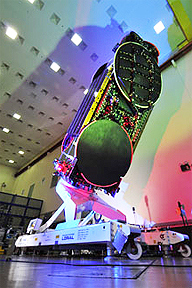
Photo of ViaSat-1 courtesy of SS/L
ViaSat Inc. (NASDAQ: VSAT) has announced that their high capacity satellite, ViaSat-1, is now positioned in geosynchronous orbit where it will begin in-orbit testing. Since launching on October 19th, ViaSat-1 has successfully completed all scheduled maneuvers:
- Deployment of solar arrays
- Six apogee motor firings, lifting the spacecraft from transfer orbit to geosynchronous orbit
- Deployment of main reflectors and sub-reflectors
- Deployment of stationary plasma thrusters for satellite positioning
ViaSat-1 is designed to transform the economics and quality of service that satellite broadband can provide. The technology is expected to elevate satellite into a much more competitive position in the broadband service marketplace, with the capacity to serve the accelerating growth in bandwidth demand for multimedia Internet access over the next decade. The high-capacity Ka-band spot beam satellite includes coverage over North America and Hawaii, enabling a variety of new, high-speed broadband services for WildBlue in the U.S., Xplornet in Canada, and JetBlue Airways on its domestic U.S. fleet.


